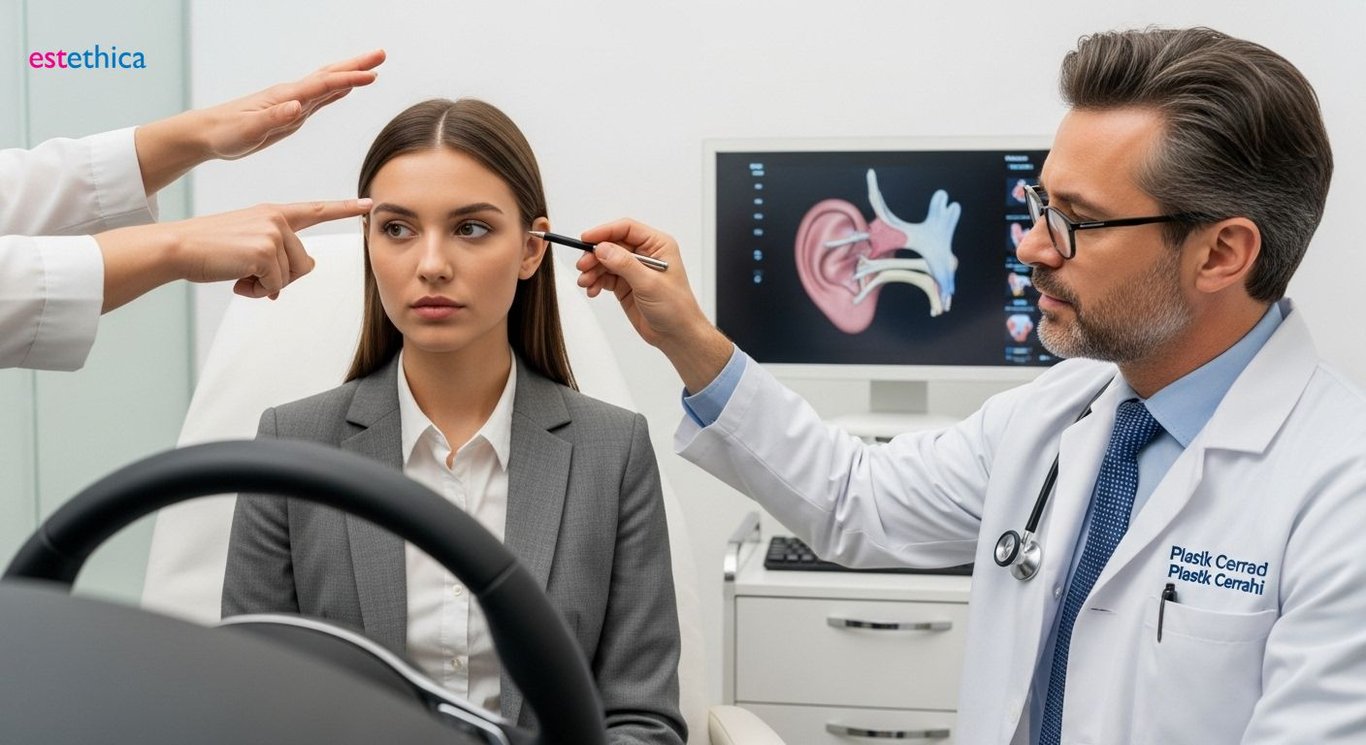Unfolding Ears: Your Guide to Ear Reshaping Surgery
Explore how ear reshaping through surgery and non-surgical options can revitalize confidence and aesthetics.
In the realm of cosmetic enhancements, ear reshaping stands out as a transformative procedure that not only enhances aesthetics but also boosts confidence. Known technically as otoplasty, this surgery is designed to correct the ear’s shape, size, or position to achieve harmony with the rest of the facial features. Whether it's addressing protruding ears or correcting previous surgeries, the impact it can have on one’s self-esteem is profound.
Understanding Ear Reshaping: More Than Just Aesthetics
The Emotional Impact of Otoplasty
Otoplasty, often referred to as ear reshaping or ear pinning, provides significant emotional benefits by enhancing self-esteem and confidence. The procedure addresses concerns beyond mere physical appearance, impacting how individuals perceive themselves and interact socially. Patients often report feeling more comfortable in social settings, leading to improved mental well-being. Ear reshaping is not just about aesthetics; it's about fostering a positive self-image.
Individuals seek ear surgery for various reasons, including prominent ears, asymmetry, or dissatisfaction with previous cosmetic ear surgery. Ear surgery can also correct deformities caused by injury or birth defects. Children and adults can both benefit from the procedure, experiencing a boost in self-confidence and a reduction in self-consciousness. Ultimately, the goal is to create a natural-looking ear shape that complements the individual's facial features.
- Improved Self-Esteem: Otoplasty can significantly boost an individual's confidence by addressing concerns about ear appearance.
- Enhanced Social Interactions: Feeling more comfortable with one's appearance can lead to increased participation and enjoyment in social situations.
- Corrected Deformities: The procedure can address both congenital and acquired ear deformities, improving overall ear symmetry and shape.
Ideal Candidates and Personalized Approaches
The ideal candidate for ear reshaping is someone who is self-conscious about the appearance of their ears and has realistic expectations about what the surgery can achieve. Surgeons at Clinique Esthetique emphasize personalized consultations to assess individual needs and goals. This ensures that each patient receives a tailored treatment plan that addresses their specific concerns. It's crucial to consider factors such as ear size, shape, and position to create a harmonious and balanced appearance.
Different techniques are used in ear pinning to address various ear concerns. Some approaches involve reshaping the cartilage, while others focus on reducing the size of the ears or correcting asymmetry. The choice of technique depends on the patient's unique anatomy and desired outcome. Advanced surgical methods aim to minimize scarring and provide natural-looking results. At Clinique Esthetique, surgeons prioritize patient safety and satisfaction, utilizing the latest advancements in cosmetic ear surgery.
- Comprehensive Consultation: A thorough assessment of the patient's ear structure and aesthetic goals.
- Customized Surgical Plan: Tailoring the surgical approach to address specific concerns and achieve the desired outcome.
- Post-Operative Care: Providing detailed instructions and support to ensure a smooth recovery and optimal results.

Pinnaplasty Unveiled: Correcting Protruding Ears for Harmony
The Pinnaplasty Procedure: Steps to Correct Protruding Ears
Pinnaplasty, a targeted form of ear surgery, specifically addresses protruding ears by reshaping the ear cartilage. This procedure aims to reduce the angle at which the ears protrude from the head, creating a more balanced and harmonious appearance. Ear pinning is often performed on both ears to ensure symmetry, although some patients may only require correction on one side. The surgery involves making an incision behind the ear to access the cartilage, which is then reshaped and secured with sutures. This meticulous approach ensures a natural-looking result that enhances facial aesthetics.
The immediate impact of cosmetic ear surgery on a patient's appearance and self-perception is considerable. Many individuals who undergo ear reshaping experience a significant boost in self-confidence, as the procedure corrects a feature that may have caused them considerable distress. The surgery is typically performed on an outpatient basis, allowing patients to return home the same day. Recovery involves wearing a bandage or headband to protect the ears and support the new shape. With proper care, the results of pinnaplasty are long-lasting, providing patients with a lifetime of improved confidence.
- Cartilage Reshaping: Pinnaplasty involves meticulous reshaping of the ear cartilage to reduce protrusion.
- Symmetrical Correction: The procedure often addresses both ears to ensure a balanced and harmonious appearance.
- Outpatient Procedure: Patients typically return home the same day, minimizing disruption to their daily lives.
Achieving Facial Harmony Through Pinnaplasty
Pinnaplasty not only corrects protruding ears but also contributes to overall facial harmony. By reducing the prominence of the ears, the procedure brings greater balance to the facial features, enhancing the individual's natural attractiveness. Ear surgery can be particularly beneficial for individuals who feel their ears draw undue attention, allowing them to feel more confident and self-assured. The subtle yet significant changes achieved through ear pinning can dramatically improve a person's overall appearance and self-esteem.
The lasting impact of pinnaplasty on a patient's self-confidence cannot be overstated. Many individuals who have undergone ear reshaping report feeling more comfortable in social situations and less self-conscious about their appearance. The procedure can also have a positive effect on a person's professional life, as increased self-assurance can lead to improved performance and greater success. At Clinique Esthetique, the goal is to provide patients with results that not only enhance their physical appearance but also improve their overall quality of life through cosmetic ear surgery.
- Initial Consultation: Discussing goals and assessing ear structure to determine the best approach.
- Surgical Procedure: Reshaping and securing the cartilage to reduce ear protrusion.
- Post-operative Care: Following instructions for optimal healing and long-lasting results.

Ear Surgery Recovery: A Guide to Healing and Optimal Results
Essential Aftercare for Ear Surgery
Recovery from ear surgery, including cosmetic ear surgery, requires diligent aftercare to ensure optimal healing and desired aesthetic outcomes. Following post-operative instructions is crucial for minimizing complications and promoting a smooth recovery. These instructions typically involve keeping bandages in place to support the newly reshaped ears, managing discomfort with prescribed pain medication, and attending follow-up appointments to monitor progress. Adhering to these guidelines is essential for achieving the best possible results after ear reshaping.
One of the most critical aspects of ear pinning recovery is protecting the surgical site from trauma and infection. Patients are advised to avoid activities that could potentially impact the ears, such as contact sports or heavy lifting. Proper wound care, including gentle cleaning and application of prescribed ointments, is also essential for preventing infection and promoting healing. By taking these precautions, patients can minimize the risk of complications and ensure a successful recovery after ear surgery.
- Bandage Support: Maintaining bandage placement to support the new ear shape and minimize swelling.
- Activity Restrictions: Avoiding activities that could potentially impact the surgical site.
- Wound Care: Gently cleaning and applying prescribed ointments to prevent infection.
Tips for a Smooth Ear Surgery Recovery
To facilitate a smooth recovery after ear surgery, patients should prioritize rest and proper nutrition. Getting adequate sleep allows the body to focus on healing, while a balanced diet provides the necessary nutrients to support tissue repair. Staying hydrated is also important for maintaining overall health and promoting optimal recovery. Additionally, patients should avoid smoking and alcohol consumption, as these can impair healing and increase the risk of complications after cosmetic ear surgery.
Managing discomfort is another key aspect of ear reshaping recovery. While prescribed pain medication can help alleviate pain, patients can also use non-pharmacological methods, such as applying ice packs to reduce swelling and inflammation. It is essential to follow the surgeon's instructions regarding medication dosage and timing to ensure effective pain management. By prioritizing rest, proper nutrition, and effective pain management, patients can enhance their recovery experience and achieve the best possible results from their ear pinning procedure.
- Adequate Rest: Prioritizing sleep to allow the body to focus on healing.
- Balanced Nutrition: Consuming a healthy diet to provide the necessary nutrients for tissue repair.
- Effective Pain Management: Following the surgeon's instructions regarding medication and non-pharmacological methods.

Non-Surgical Ear Correction: Exploring Alternative Options
Understanding Ear Molding and Splinting for Infants
For parents exploring alternatives to ear surgery, non-surgical methods like ear molding and splinting present viable options, especially for infants. These techniques leverage the natural flexibility of infant cartilage to gently reshape the ears without invasive procedures. Ear molding involves using a soft, pliable mold to conform the ear into the desired shape, while splinting employs specialized splints to achieve similar results. Early intervention is key, as these methods are most effective within the first few months of life, when the cartilage is still highly malleable. Clinique Esthetique emphasizes the importance of consulting with a specialist to determine the suitability of these methods for your child.
Non-surgical ear correction offers a moderate degree of improvement, addressing issues such as prominent ears or minor deformities. While these methods may not achieve the dramatic results of cosmetic ear surgery, they provide a non-invasive way to improve ear shape and appearance. Parents often appreciate the simplicity and convenience of ear molding and splinting, as they can be performed at home with regular follow-up appointments. It's essential to have realistic expectations and understand that the success of these methods depends on factors such as the infant's age and the severity of the ear deformity. Clinique Esthetique provides comprehensive guidance and support to families considering non-surgical ear correction for their children.
- Early Intervention: Non-surgical methods are most effective when started within the first few months of life.
- Gentle Reshaping: Ear molding and splinting use gentle pressure to reshape the cartilage without surgery.
- Convenient Application: These methods can often be performed at home with regular follow-up.
The Effectiveness and Limitations of Non-Surgical Methods
The effectiveness of non-surgical ear correction largely depends on the age of the individual. Infants benefit most due to the pliability of their ear cartilage, while older children and adults may find these methods less effective. Ear molding and splinting are typically used to correct issues such as Stahl's ear, lop ear, and prominent ears. The process involves consistent application of the molding or splinting device over a period of weeks or months, requiring patience and diligence from parents. At Clinique Esthetique, specialists carefully assess each case to determine the likelihood of success with non-surgical methods.
While non-surgical methods offer a less invasive alternative to ear pinning, they do have limitations. Significant deformities or cases where the cartilage has already hardened may not respond well to molding or splinting. In such instances, ear reshaping through surgical intervention may be the more appropriate option. Non-surgical methods are also not suitable for correcting internal ear structure issues. It's crucial to consult with an experienced surgeon at Clinique Esthetique to explore all available options and determine the best course of action for achieving the desired aesthetic outcome through cosmetic ear surgery or non-surgical alternatives.
- Consultation: Assess the infant's ear structure and determine the suitability of non-surgical methods.
- Application: Consistently apply the molding or splinting device as directed by the specialist.
- Follow-up: Attend regular appointments to monitor progress and make adjustments as needed.
Otoplasty: Achieving Facial Harmony Through Personalized Ear Reshaping Techniques
estethica specializes in otoplasty, employing both surgical and non-surgical methods to correct ear deformities and enhance facial aesthetics. Their expertise includes pinnaplasty for protruding ears and ear molding/splinting for infants, ensuring tailored treatment plans based on individual needs.
estethica's surgeons possess extensive experience in cosmetic ear surgery, focusing on natural-looking results and patient satisfaction. They prioritize comprehensive consultations to assess each patient's unique anatomy and aesthetic goals, utilizing advanced surgical methods to minimize scarring and ensure optimal outcomes.
Diligence in Aftercare Ensures Smooth Recovery and Optimal Results in Ear Surgery
estethica emphasizes diligent aftercare to ensure optimal healing and desired aesthetic outcomes following ear surgery. Post-operative instructions, including bandage support, activity restrictions, and proper wound care, are provided to minimize complications and promote a smooth recovery.
Patients at estethica experience a boost in self-confidence and overall quality of life through cosmetic ear surgery. The hospital's commitment to patient safety, personalized care, and natural-looking results ensures a positive experience and long-lasting satisfaction.
Frequently Asked Questions
What is ear reshaping or otoplasty, and who is it for?
What does ear pinning (pinnaplasty) involve, and what results can I expect?
What is the recovery process like after cosmetic ear surgery?
Are there non-surgical alternatives to ear surgery, and how effective are they?
What are the benefits of choosing ear reshaping or cosmetic ear surgery?
Ready to discover your healthy beauty with estethica's expert team?
📞 Call Now for a Free Consultation!